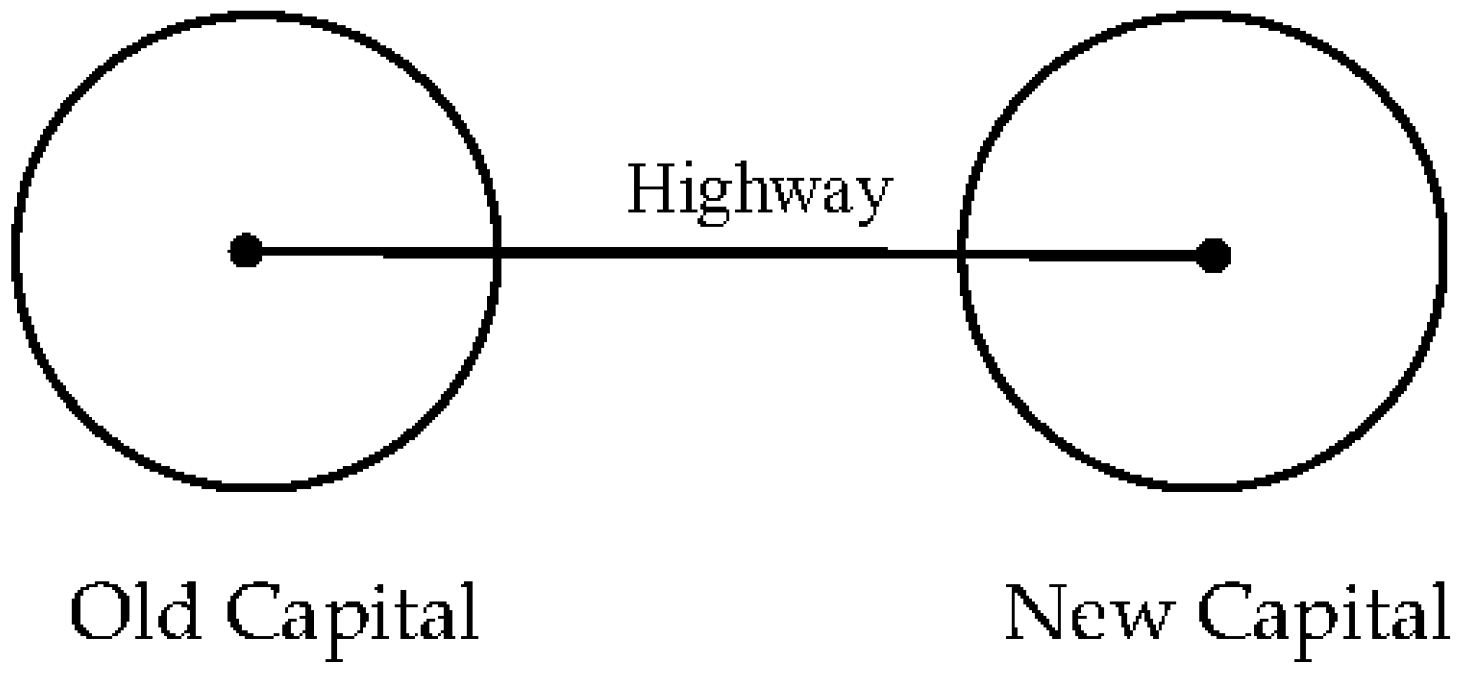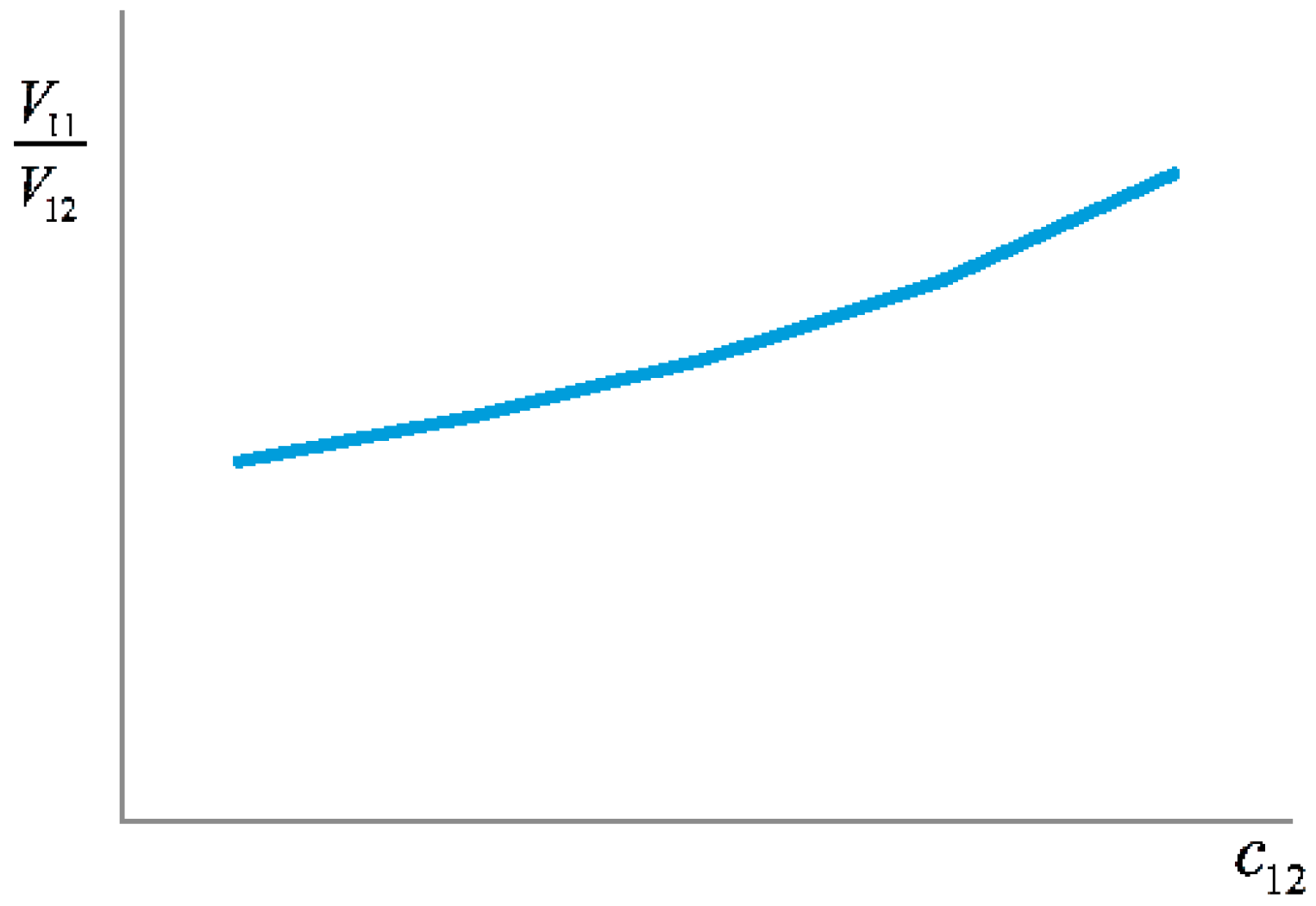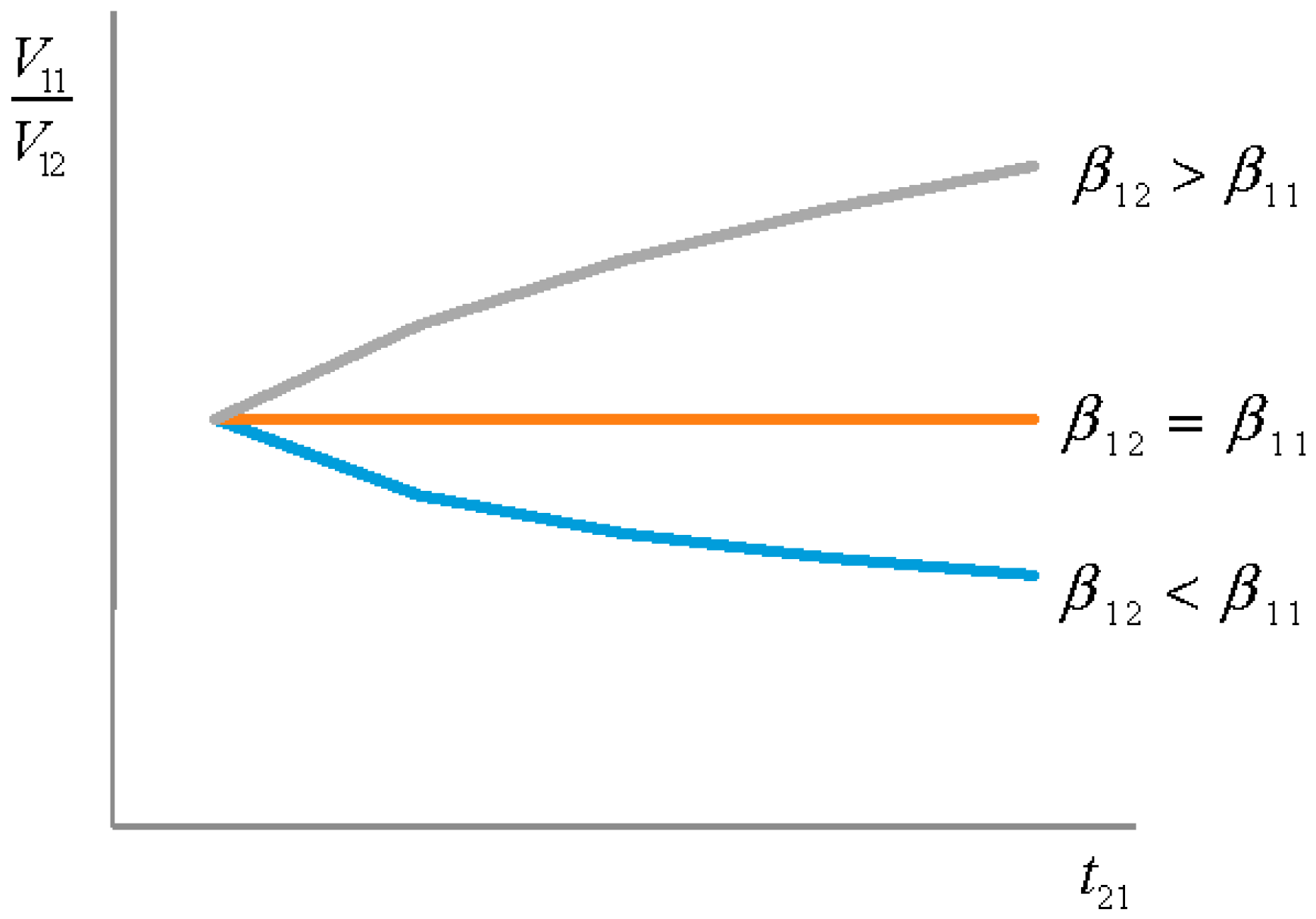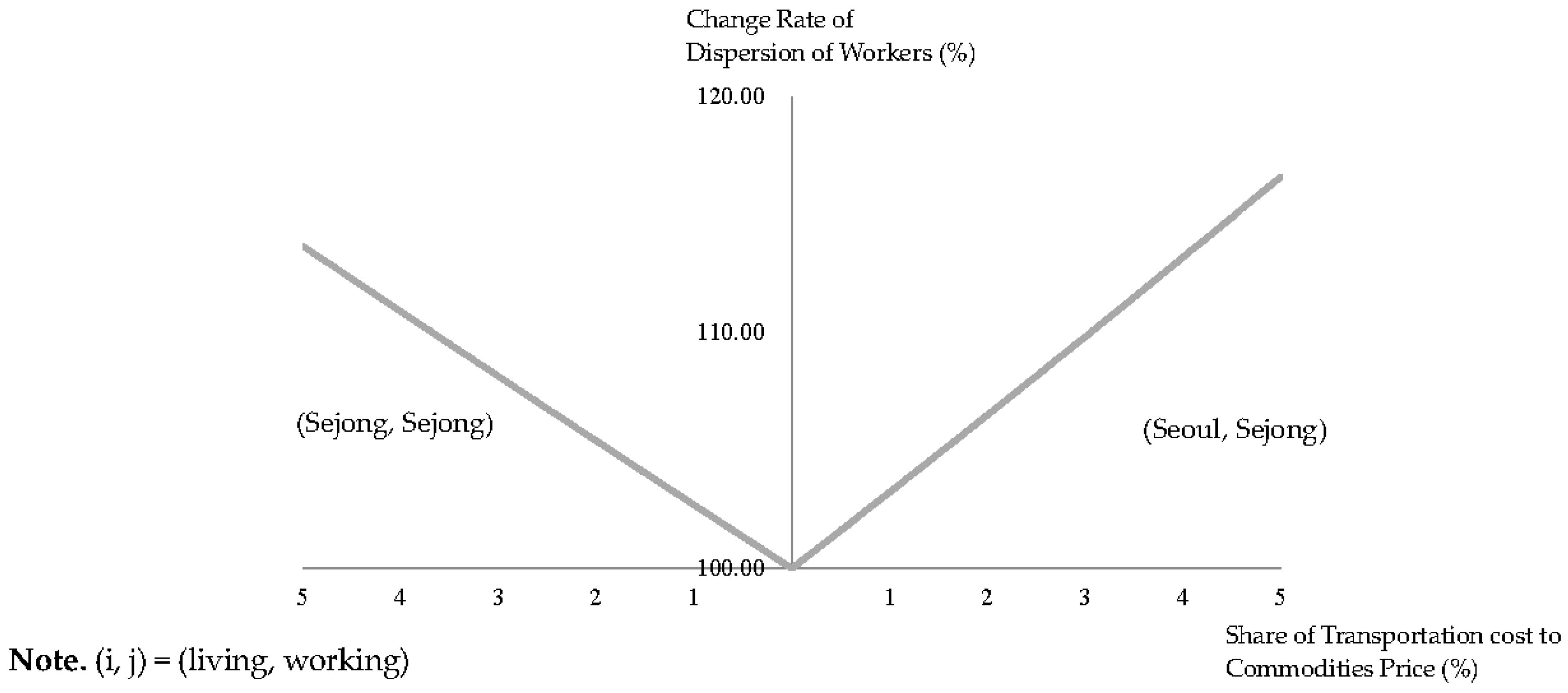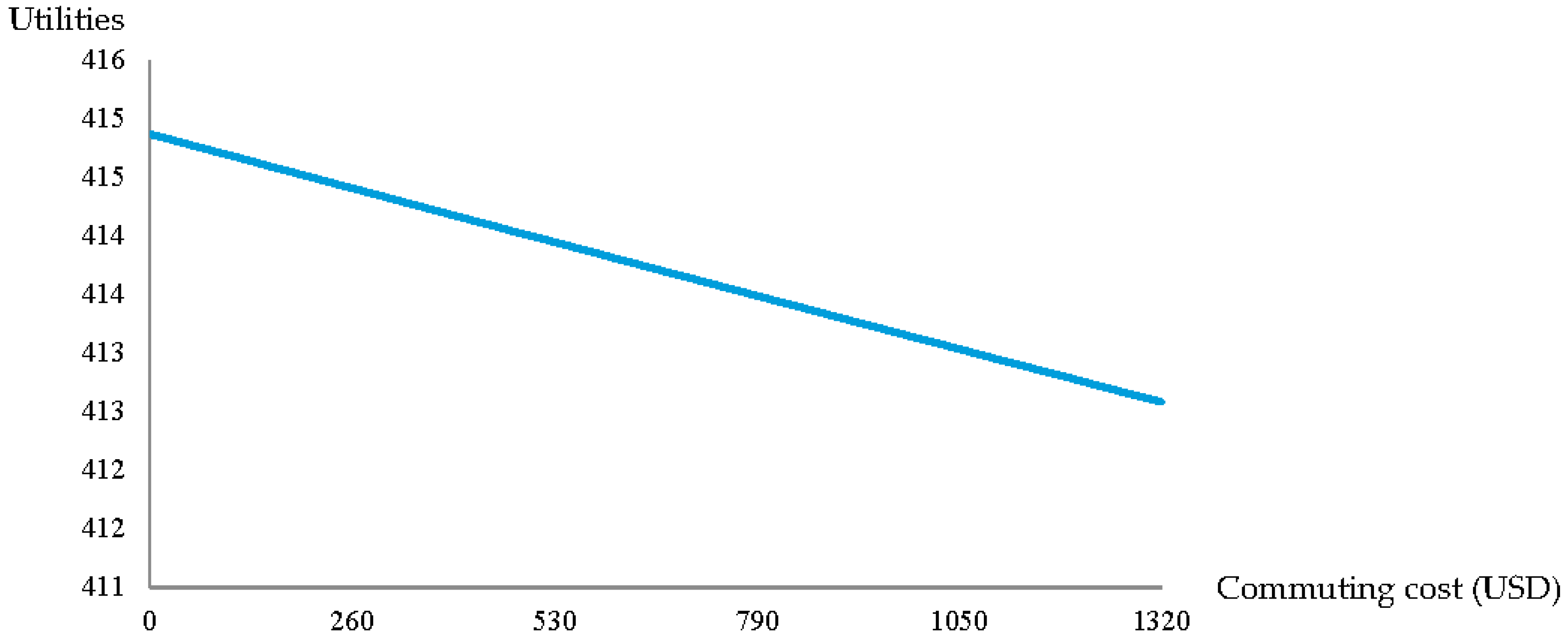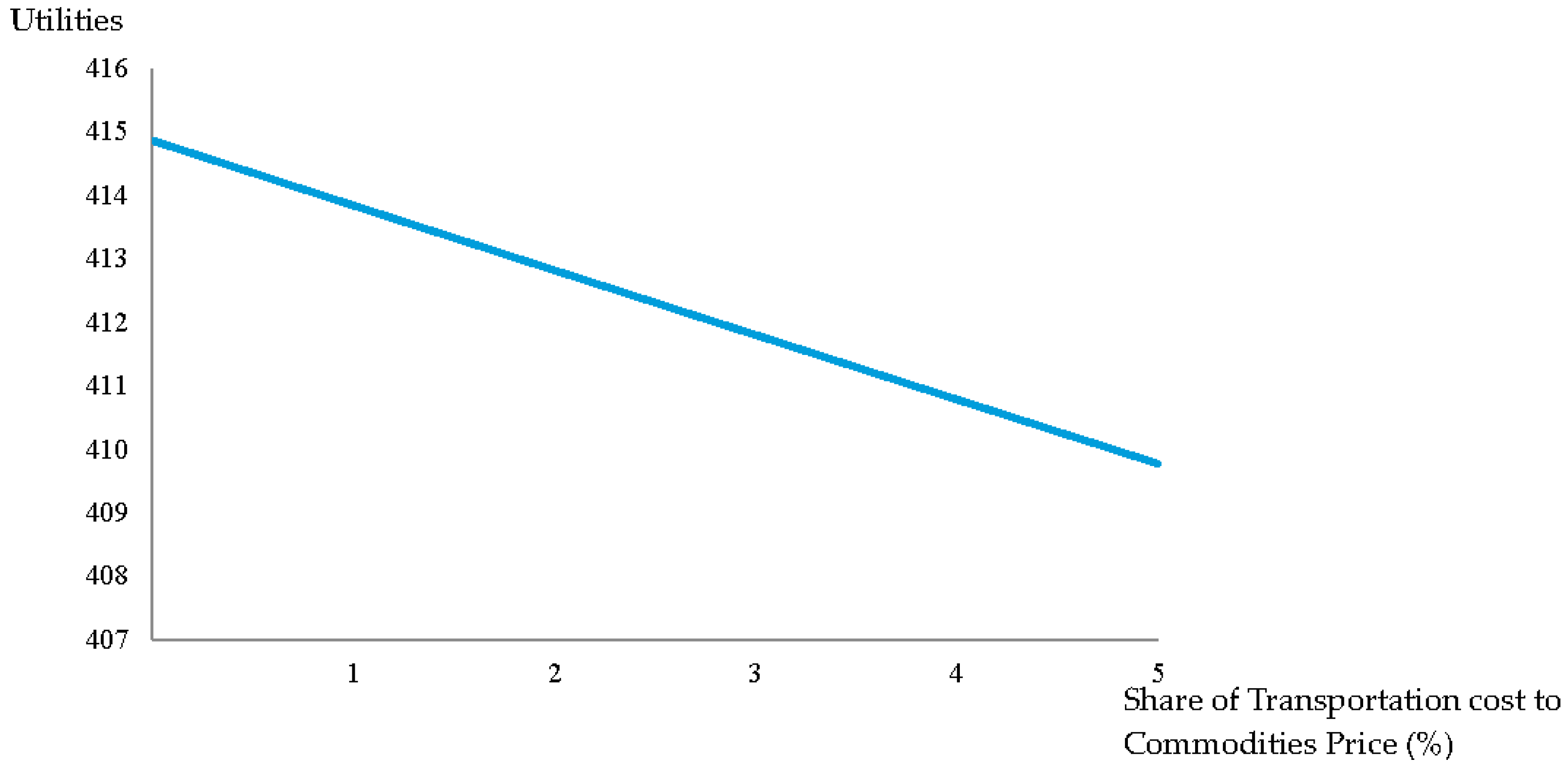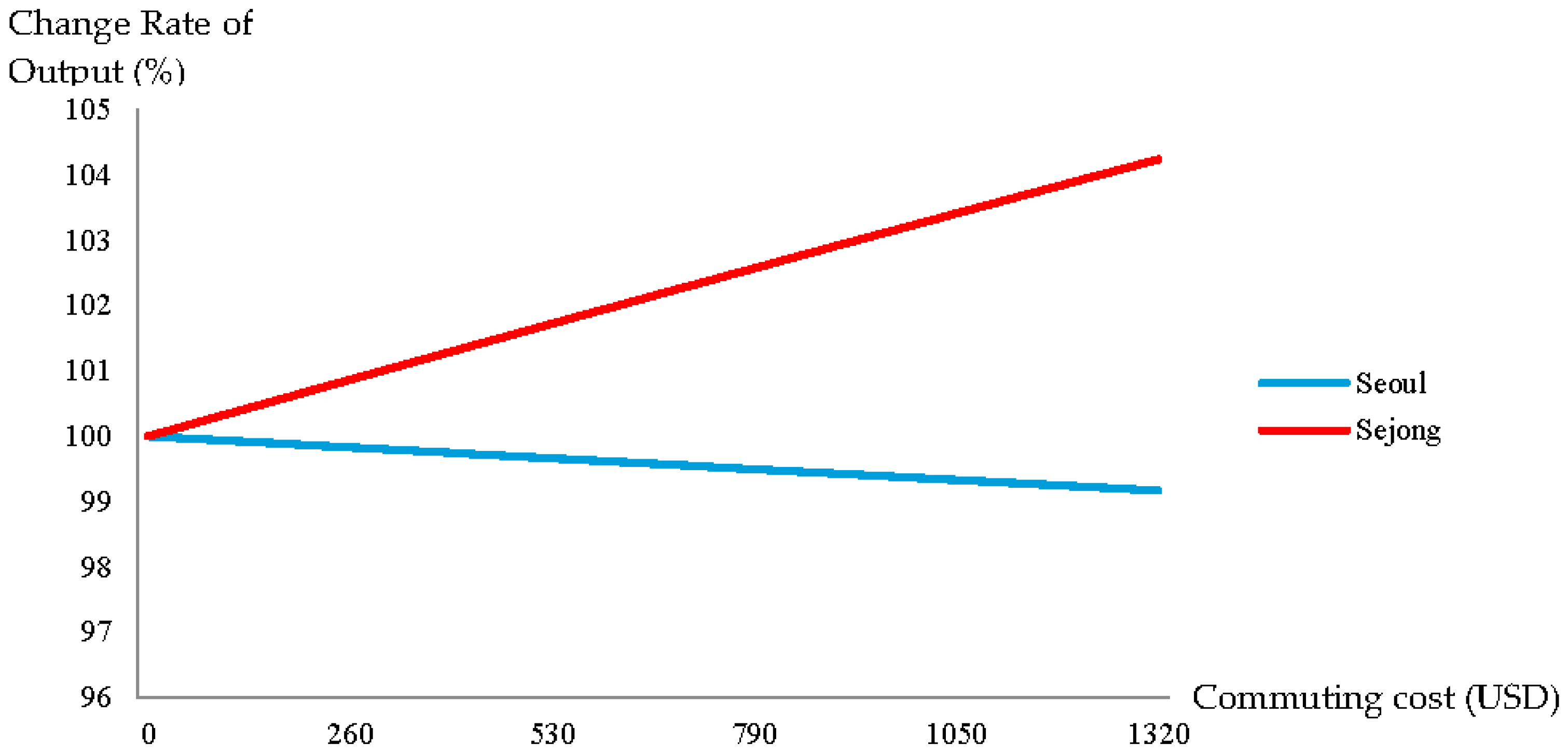1. Introduction
Economic concentration in Seoul, the capital city of Korea, has had a negative impact on urban sustainable growth, interregional balanced development, the housing market, and environmental pollution [
1]. To tackle this issue with policy tools, the Korean government decided to relocate 36 government ministries and agencies from Seoul to Sejong city (approximately 160 km south of Seoul, the capital city of Korea), the new administrative capital, in 2007, with the Presidential Office, the National Assembly, and all the foreign embassies remaining in Seoul. This location policy is not new for Asian countries. Malaysia constructed a new administrative capital, Putrajaya, in the early 1990s, and has transferred the federal administrative offices to this capital. Indonesia and Japan have discussed the construction of new administrative capital cities since the 1980s.
The success of this relocation as a strong population dispersion tool depends on the outflows of government officers and families from Seoul and subsequent relocations of major commercial and financial facilities. For example, the planned population size of Putrajaya in Malaysia is 340,000 by 2025, but the actual size as of 2015 is only 83,000. Sejong City aims to grow into a sustainable self-sufficient city with a population of 500,000 by 2030, but the population size remains at roughly 40% of the population goal. What are the practical policy options for the government to achieve this planning target? In the sense that spatial economic activities have been assessed in terms of transportation costs and agglomeration economy, this paper is concerned with the economic contribution of transportation and mobility costs to the migration between the old and the new capital cities.
The purpose of this paper is to analyze the effects of transportation costs on the mobility of workers and the general population between the old and new capital cities using a two-region growth model. Previous studies have analyzed a spatial framework between two regions, in each of which workers can reside or work. They divided mobility on the interregional level into commuting and migration depending on relocation decisions between two regions [
2,
3,
4]. This paper attempts to examine the impacts of transportation and mobility costs on consumers’ utility and the spatial distribution of workers. Transportation cost is logistically defined as the shipping (trade) cost of commodities, whereas mobility costs are the costs of commuting and migration of workers [
3]. In addition, the financial subsidies to move workers from the old capital to the new capital are derived from the comparative analysis of the theoretical model. The paper proceeds as follows:
Section 2 presents a literature review on the effect of transportation costs and migration;
Section 3 develops a simple two-region model;
Section 4 explores the comparative analysis;
Section 5 performs a numerical simulation with the use of transportation and commuting costs; and
Section 6 summarizes this paper and discusses further research issues.
3. The Model
We assume a simple two-region (the old capital and the new capital,
Figure 1) growth model based on Alonso (1964), Krugman (1991), and Sorek (2009). This model identifies the impacts of transportation and mobility costs on the regional economies [
3,
30,
31]. Travel refers to mobility travel such as commuting and migration, with mobility costs. Commuting cost is incurred between two regions, but not within each region. Migration cost refers to the costs implicated in relocating. Commodities are traded between two regions, and so transportation cost, such as the shipping (trade) cost of commodities, is incurred in iceberg form. Each region produces different commodities. The labor input (worker) is assumed to be the only production factor. Agglomeration economies are represented as a function of the population. Commuting and migration costs, transportation cost, and total labor inputs are exogenous. Labor inputs can be disaggregated into four groups with respect to living and working locations. The four groups are as follows: living and working in the old capital; living and working in the new capital; living in the old capital, but working in the new capital; and the opposite of the third group.
Labor is supplied by the household. House members produce K + 1 times labor input in each house. The total population in each region is shown as in Equation (1). The size of the total population is fixed.
Population (Each region has non-zero population)
Ni: Population in region i;
Lij: Labor input living in region i and working in region j;
Production is determined by a Cobb–Douglas function for labor inputs and agglomeration economies. The latter implies that the personal interactions involved in the production and output sales contribute to the productivity of firms. The price decreases with the population because
g(
Ni) represents scale effect, which represents agglomeration economies as urbanization economies, as measured by population in each region [
32]. In this study, the population size is affected by relocation decisions, depending on transportation cost and mobility costs. Each household supplies homogenous labor, and the total labor inputs refer to the total man/hour. In terms of living and working locations in
Table 1, for example, output
X in the old capital is produced by
L11 (workers living and working in the old capital) and
L21 (workers living in the new capital, but working in the old capital).
Xi: Aggregate output in region i;
Ai: Scale factor;
Lii: Labor input living and working in region i;
Lji: Labor input living in region j and working in region i;
g(Ni): Agglomeration economies function of population in region i;
δ + θ = 1;
0 < δ, θ < 1.
Firms maximize their profit. The conditional input demand functions for each worker are as follows under perfect competition.
Demand of each worker in region i Only the household is assumed to supply labor and consume the commodities in each house in this model. Consumers maximize the utility to consume two different regional commodities. The regional import is consumed at the transportation cost-inclusive price because of the shipping (trade) of the commodities. The transportation cost (t) is assumed to be greater than 0.
ziij: Commodities produced in region i that are consumed by workers living in region i and working in region j;
zkij: Commodities produced in region k that are consumed by workers living in region i and working in region j;
αij + βij = 1;
0 < αij, βij < 1.
The household income is determined by the wage level. Total monthly income of a household is shown in Equation (8).
where
yij is the monthly income of the household, excluding the mobility costs.
H indicates the total monthly working time. This study did not adopt a time constraint, because a simple two-region growth model was used instead of a time-extended model. In addition,
d is the working days in a month, and
cij represents the commuting cost between the two regions.
mij is the migration cost, which is incurred only when the living site is changed. Consequently, the budget constraint function of the household is shown in Equation (9). In addition, the Marshallian demands for each commodity are presented in Equations (11) and (12).
Demand of the house
where
pi is the price of a commodity in region
i, and
p’i represents the price of a commodity in region
k (
pk) plus the transportation cost from region
k to region
i (
tki). Finally, the maximized utility level (
Uij = Vij + εij) is derived from Equation (13).
The choice of living and working locations could be achieved through the maximized utility, Equation (13). This choice could be specified in the form of a probability. Assuming that
εij is independently identically distributed and follows Gumbel distribution (mean, zero, and variance,
σ2:
σ2 = π
2/6λ
2), the choice probability of living and working sites is equal to Equation (14).
λ is called the taste heterogeneity parameter. If
λ approaches infinity (∞), the taste heterogeneity disappears.
The probability that a randomly identified household chooses the living and working sites (
i,
j) to maximize the utility is calculated with the quadrinomial logit model (
Prij = Prob [
Uij >
Uks; ∀(
i,
j) ≠ (
k,
s)] = Prob [
Vij +
εij >
Vks +
εks; ∀(
i,
j) ≠ (
k,
s)], ∑
Prij = 1) [
14].
The expected welfare measure can be expressed as follows:
The general equilibrium is computed from the market clearing for output, labor, and competitive market.
4. Comparative Analysis
4.1. Transportation and Mobility Costs and Utilities
We assume two alternative mobility scenarios with regard to workers and population mobility from the original case of living and working in the old capital. The symmetric spatial distribution of population is initially assumed: N1 = N2.
Alternative I: Changing the working site from the old capital (i = 1) to the new capital (j = 2)
From
L11 to
L12, only the workers can change the working site through commuting. The population of the old capital does not change. The real income earned by a worker living in the old capital but working in the new capital decreases because of commuting cost
c12. The utility
V12 is negative in
L12. This result may be related to the commuting cost.
()
In this case, even if the workers’ mobility occurs, the total population in each region does not change. Additional subsidy or incentives are needed to induce commuting to the new capital on the condition of the utility
V11 <
V12 because
2dc12 >
w2H.
Figure 2 shows that the gap between two utilities increases according to the rising commuting cost. Commuting cost negatively affects the utility of workers living in the old capital, but working in the new capital.
Figure 3 shows how the transportation cost affects the ratio of utilities. Transportation cost affects the real income and the commodity’s price.
β11 and
β12, the parameters of the preference for the commodity produced in the new capital, affect the ratio of the two utilities. If a worker who lives in the old capital but works in the new capital prefers the commodity produced in the new capital more than a worker who lives and works in the old capital, the gap of utilities increases with the transportation cost. The increasing transportation cost influences the price and affects the utility negatively. Additionally, the production of this commodity in the new capital increases, and ultimately raises the nominal wage in the new capital. This effect increases the welfare of the population, including the workers living in the old capital, but working in the new capital.
Alternative II: Migrating to the new capital and changing the working site
From
L11 to
L22, the population, including the workers, migrates to the new capital, and the working site also changes. The population in the new capital increases. The nominal wage in the new capital also increases, whereas the nominal wage in the old capital decreases. Migration cost is incurred. The utility
V22 is positive in
L22. This result is caused by the increasing wage in the new capital.
Migration decreases the population in the old capital. It is possible that
V22 >
V11 if
w2H is larger than
m2 [
N22/(
N12 + N22)]. If the household income is large enough to compensate for the migration cost without any subsidy or incentive, migration benefits the population, including the workers.
Figure 4 shows that the gap between the two utilities increases according to the rising migration cost. Migration cost affects the utility of worker migrating to the new capital.
In
Figure 5, as the transportation cost
t12 increases, the price of the commodity produced in the old capital increases. Hence, the utility of the workers living in the new capital after migration is negatively affected. The gap of utilities widens according to the increasing transportation cost
t12. However, when the transportation cost
t21 increases, the gap of utilities decreases. This result is related to the price of the commodity produced in the new capital, which the workers living and working in the old capital pay. This result negatively affects the utility
V11.
In summary, as the population including the workers migrates to the new capital, the nominal wage in the new capital increases, whereas the nominal wage in the old capital decreases. Utility is also directly related to the nominal wage or real income. Transportation cost negatively affects the price of the commodity and the utility. The effects of commuting and migration costs on the utility are negative. A financial subsidy is needed to enable workers to commute from the old capital to the new capital.
4.2. Agglomeration Effect and Utilities
Agglomeration economies arise from the total population in each region. The utility may be affected by agglomeration factors, parameters, and population size. The agglomeration effects of the increasing region size can induce urban costs, such as congestion or disamenity.
Alternative I: Changing the working site from the old capital (i = 1
) to the new capital (j = 2
) In Alternative I, the population in each region is constant, and the utility changes in a declining degree or according to elasticity ν. The utility is opposite in ν. Thus, the utility of the workers living in the old capital but working in the new capital is affected only by a declining degree of agglomeration economies.
Alternative II: Migrating to the new capital and changing the working site The population, including the workers, migrates to the new capital, and the working site also changes. Therefore, the population in the new capital increases. The utility of the workers living and working in the new capital increases due to the improved agglomeration effects. In the change of ν, the slope of the utility is less steep.
Finally, even if transportation and mobility costs negatively affect the utility, agglomeration economies improve in the increasing population through migration. The utility of the workers living and working in the new capital increases due to the improved agglomeration effects.
5. Numerical Simulation
Empirically, it is set that the old capital is Seoul, and the new capital is Sejong City (Sejong). The number of workers living in Seoul and Sejong are 11 million and 3.5 million, respectively. The initial data are obtained from Statistics Korea. This analysis discusses the spatial dispersion of workers depending on relocation decisions between Seoul and Sejong, as well as their effect on regional economies. The change in commuting and transportation cost is considered under static conditions. The dispersion of workers in each living and working site is interpreted as the change rate of the initial value set to 100.
Figure 6 and
Figure 7 illustrate the effects of change in commuting and transportation cost on the dispersion of workers, respectively. The first dimension indicates the case of living in Seoul, but working in Sejong. The second dimension is the case of living and working in Sejong. The change rate of the dispersion of workers steeply responds to the change in transportation cost, as shown in
Figure 7. As the commuting cost increases, the number of workers living and working in Sejong sharply increases. However, the choice probability of living in Seoul, but working in Sejong increases marginally, despite the commuting cost.
In conjunction with
Figure 6,
Figure 8 shows the relationship between the change of workers living in Seoul but working in Sejong, and the change of commuting cost. This indicates that commuting stops when the monthly commuting cost exceeds 1290 USD—about 26.1% of the monthly average income of urban households with four members in Korea—at constant price. The higher commuting cost results in the dispersion of workers to Sejong. This implies that the population may increase naturally and foster the economic activities in Sejong.
Figure 9 shows the positive relationship between the number of workers living in Sejong and the higher transportation cost. This implies the dispersion of workers from Seoul to Sejong. Krugman (1991) and Kilkenny (1998) proved that the concentration in the old capital is favored by the reduction in transportation cost [
6,
31], while Murata and Thisse (2005) suggested that a higher transportation cost fosters labor concentration and agglomeration in the region [
9]. At a lower transportation cost, more workers live in Seoul, and the population ultimately increases. Originally, 11 million workers, out of the total 14.5 million workers in the two regions, live in Seoul. However, since transportation cost is rising, the number of workers living in Sejong is increasing. If the share of transportation cost to commodity’s price reaches up to 60.1%, the workers will be balanced between Seoul and Sejong.
Figure 10 and
Figure 11 illustrate the relationship between the transportation or commuting cost and utilities. The higher transportation or commuting cost negatively affects the utilities, even if they contribute to the dispersion of workers. The effect of increasing transportation cost on utilities is greater than that of increasing commuting cost.
Figure 12 and
Figure 13 show that output in Sejong increases with the rising transportation and commuting cost. This is related to the scale effect of agglomeration economies.
Consequently, the lower transportation and commuting costs foster the concentration of workers in Seoul. Paradoxically, the higher transportation and commuting costs induce the dispersion of workers to Sejong, and positively affect the output growth. However, the social welfare decreases, as indicated by Kilkenny (1998) [
6]. Kilkenny (1998) pointed out that rural development could only be achieved at a lower overall welfare [
6]. In the sense that 1290 USD is the maximum amount for the commuters to pay from Seoul to Sejong, the government needs to restrict the financial subsidy allocated to them in order to increase the population size of Sejong. If the share of transportation cost to commodity price reaches 60.1%, the interregional population equilibrium could be achieved. In addition, for the sustainable growth of Sejong, it is necessary to implement in-migration policy tools such as improvement of living quality (e.g., housing supply and amenities) and the development of public infrastructure facilities (e.g., transportation and disaster prevention).
